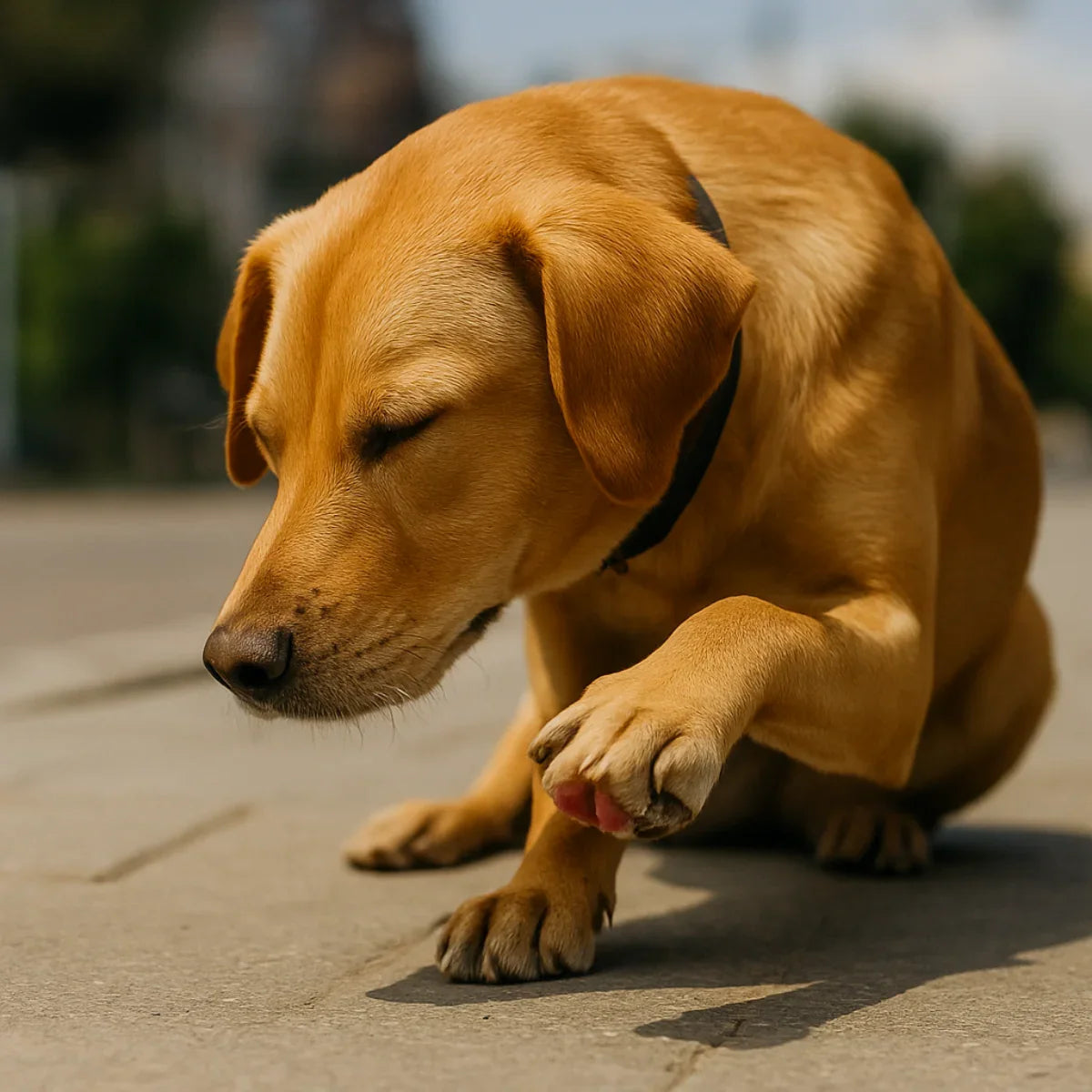
Dog paw burns in summer – how to protect your pet from the heat?
In summer, the city turns into a concrete frying pan – a dangerous trap for dogs
Summer sun, blue sky, hot air shimmering across the sidewalk—seemingly perfect weather for a walk. It seems like a moment of joy, especially when your dog waits by the door, tail wagging excitedly. But beneath this apparent idyll lurks a silent but serious threat — scorching asphalt and concrete , which can turn an ordinary walk into a painful tragedy.
While we humans wear shoes, our dogs walk barefoot . Their paw pads, delicate and sensitive, are not designed for contact with surfaces that, in full sun, can reach temperatures exceeding 60 or even 70 degrees Celsius . For comparison, this temperature is enough to fry an egg in a pan in seconds. Now imagine your dog placing a paw on this hot "plate."
You don't have to walk halfway across town. Just a few dozen seconds of walking on a hot sidewalk is enough to cause first- or second-degree burns . Sometimes your dog doesn't even have time to protest – adrenaline and the instinct to follow you cause the suffering to manifest itself only after you get home : swelling, blisters, and even skin peeling from their pads.
Dog paw burns are a real, common problem that worsens day by day in the summer , especially in cities where concrete and asphalt store heat, creating so-called urban heat islands. In such conditions, even an evening walk on a hot sidewalk can be dangerous for a dog.
This article was created to raise awareness. It will answer questions every dog owner should be asking this summer :
- Why are concrete and asphalt so dangerous for dogs' paws?
- What temperatures do urban surfaces reach and when do they pose a threat?
- How to prevent dog paw burns ?
- What are the first symptoms of a burn and how to provide first aid to a dog ?
- Where is the best place to walk in the heat and why is the forest a natural, cool oasis ?
Knowledge is the best protection. This guide will help you understand how small changes to your dog's daily routine can save you from pain and stress , and spare you a dramatic trip to the vet. Walking should be a joy—not a drama.
Read to the end and learn all the ways to have a safe summer with your dog in the city and beyond .
What temperatures do concrete and asphalt reach in hot weather? Facts that may shock you.
On a hot day, the city turns into an oven. The sun shining directly onto the sidewalk causes the surfaces to store heat. Concrete, asphalt, and even dark paving stones absorb the sun's rays and release them back into the surroundings.
Many dog owners don't realize how quickly asphalt heats up and how long it stays hot – even after the sun goes down.
Here are the specific details:
| Air temperature | Asphalt temperature |
| 25°C | 52°C |
| 30°C | 57–62°C |
| 35°C | 65–70°C |
➡️ 51°C is enough for a dog to suffer second-degree burns after just 60 seconds of contact with the ground!
➡️ At a temperature of 60°C, a dog can suffer burns in just 15 seconds !
This type of data is confirmed by research, including from American and European veterinary organizations. Walking on such a hot surface is like stepping on a heated grill.
Why is the forest the best place for a summer walk with your dog?
Unlike the city, forests and green spaces offer dogs what they need most in summer: shade, coolness, and natural habitats . When concrete is scorching and asphalt can feel like a hot stovetop, the forest floor and moist soil are a dog's salvation.
Benefits of forest walks in summer:
🌲 Lower temperature – the difference between a concrete sidewalk and a forest path can be as much as 10–15°C.
🌳 Natural insulation – mulch, leaves and moist soil do not heat up as much as asphalt.
🍃 Better air ventilation – in the forest the air circulates, it does not stagnate like in built-up urban spaces.
💧 Increased humidity – helps the dog breathe and improves thermal comfort.
🦴 More stimuli – smells, leaves, rustling twigs – all this gives the dog the pleasure of exploration .
🔔 Warning! Walking in the forest also carries a risk of contact with ticks – always use protective products before going out.
Read more: 👉 Ticks on dogs
Choose a product that will make your walk more pleasant:
Symptoms of dog paw burns – what should you be concerned about?
Your dog won't tell you he's in pain - but his body will send clear signals if you learn to read them.
Symptoms of a minor burn:
- reluctance to continue walking,
- lifting one or more paws,
- licking or biting paws after returning home,
- reddened paw pads,
- slight swelling.
Symptoms of a moderate to severe burn:
- pronounced pain when touching the paws,
- blisters,
- traces of blood,
- skin peeling from the pad,
- the dog does not stand on one of its paws or is limping,
- visible change in behavior – apathy, whining, nervousness.
If you notice the above symptoms, stop walking and seek first aid .
First aid for burnt paws – step by step
If your dog has suffered burns to its paws, time is of the essence . Act quickly and calmly.
🔹 Step 1: Cool the paws
- Soak them in cool (not ice cold!) water for 5–10 minutes.
- You can use moist, cold compresses.
🔹 Step 2: Clean the wound
- Use saline or boiled water .
- Do not use alcohol, iodine or hydrogen peroxide – they may worsen the condition.
🔹 Step 3: Apply protective ointment
- Preferably with aloe, panthenol or a special veterinary ointment.
🔹 Step 4: Secure the paws
- Apply a loose gauze dressing to prevent your dog from licking the wound.
- You can apply a hydrogel dressing if you have access.
🔹 Step 5: Contact your veterinarian
- Even if the injury seems minor, consultation may be necessary – especially if a blister has developed or the dog has stopped walking.
Treating dog paw burns – what will the vet do?
Depending on the severity of the burn, your vet may use:
- antibiotic ointment or oral if there is a risk of infection,
- anti-inflammatory and painkillers ,
- specialized dressings (hydrogel, cooling),
- recommendation to limit activity – sometimes it is necessary to wear protective shoes during recovery.
How to Prevent Paw Burns? A Conscious Caregiver's Guide
Prevention is better than cure – this is a rule that applies perfectly to dog burns.
✅ Plan your walks strategically
- Walk your dog in the morning (until 9:00 a.m.) and in the evening (after 7:00 p.m.).
- Avoid walking in full sun and on concrete.
✅ Walk on safe ground
- Look for a lawn, forest, park, field .
- Vary your routes to avoid asphalt and paving stones.
✅ Check the surface with the palm test
- If you cannot hold the touch with your hand for 5 seconds, the dog should not go there .
✅ Dog safety boots
- Perfect for short city walks.
- Not every dog tolerates them, so teach him to wear shoes gradually .
✅ Protective creams and balms
- Available in good pet stores or from your vet.
- They create a protective layer on the fingertips.
The most common mistakes of caregivers – what to avoid?
❌ Ignoring the heat – “it’s only 5 minutes.”
❌ Assuming the dog will say it hurts – dogs often suffer in silence.
❌ Failure to observe paws after a walk – better to observe than to miss.
❌ Lack of water during a walk – dehydration worsens skin immunity.
Summary: Safe summer = smart choices
Hot weather doesn't have to mean giving up on walks with your pet – just change your habits and carefully monitor the conditions . Remember:
🟢 Avoid hot surfaces
🟢 Walk during the cooler hours of the day
🟢 Choose a forest, lawn, or park instead of the city
🟢 Protect your paws with cream or shoes
🟢 In case of burns – react immediately
Loving a dog isn't just about affection and treats. It's, above all, about conscious responsibility —including for where your dog steps.
📚 Additional materials
- How to Tell If Your Dog Is Bored: 10 Signs You Can't Ignore
- TOP 10 Most Intelligent Dog Breeds – Which Ones Will Surprise You With Their Cleverness?
- Best dogs for apartments – breed ranking
- How Do Dogs Show Affection? Signals You Should Know
- Is Your Dog Pulling on the Leash? Find Out How to Fix It
- How to safely transport a dog in a car?
-
How to teach your dog to stay home alone
See more at: Petto.com.pl








 https://petto.com.pl/
https://petto.com.pl/